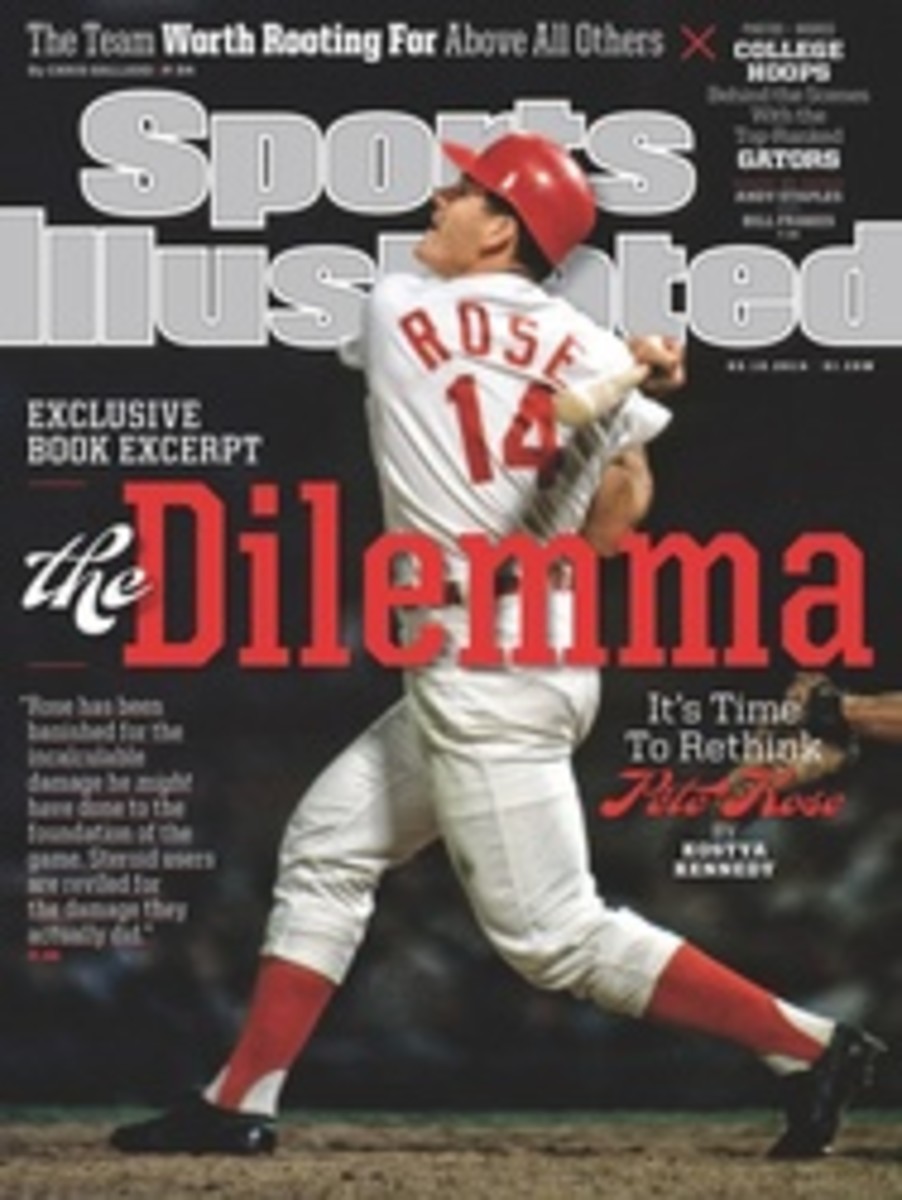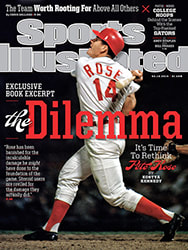
Great Outdoors
Before the 2013--14 season, the NHL announced its most ambitious outdoor slate. Every season since '07--08 has had precisely one outdoor game, except for '13 (no game, lockout) and '10--11, which had two, on account of the reappearance of Canada's Heritage Classic.
This year there have been six spread over five venues. In late January, the Rangers and the Devils played before 50,105 in frigid Yankee Stadium (25° at puck drop, with a mean windchill) just hours after the Kings and the Ducks had entertained 54,099 in balmy Dodger Stadium (63° at face-off, with humidity). Go big, or go indoors.
Last Saturday night they came to Soldier Field in droves, the fans and the snowflakes, for the game between the Penguins and the Blackhawks. The two clubs have star power (Sidney Crosby and Evgeni Malkin for the Pens; Patrick Kane and Jonathan Toews for the Hawks) and three of the last five Stanley Cups. Tickets sold out in less than 24 hours. And Mother Nature? Well, she must have reasoned that 62,921 people couldn't be wrong.
Were they? I put on three pairs of tube socks, boots, two pairs of leggings, jeans, one undershirt, two light sweaters, one heavy sweater, one wool-cashmere pea coat (unbuttoned, owing to the bulkiness of the ensemble) and two wool hats to find out. The league provided me with two warming pouches to stick in my boots. I don't like to take freebies, but it was 17° at face-off, with snow falling fast and hard, and my toes needed every last BTU.
I LEARNED in Chicago that outdoor hockey's tableau varies from every seat. At ice level, where I sit with NHL operations executives for one period, the players cut the imposing figures they do in arenas, but encased by the open sky and the hulking, fan-filled structure of Soldier Field, they seem smaller, inconsequential. Until, that is, one slams another against the glass two feet in front of your face and shakes loose an inch and a half of snow from the outer ledge of the boards. Precipitation and plein air be damned; this is no snow globe, it's hockey.
But high above the action, in section 445, an upper corner, the game shifts to a different scale. I'm not so far away that I can't follow the play, and yet the view's charms have little to do with the way I see the puck. Instead I find myself periodically breaking from the action to watch the snowflakes, now lighter, dancing in the stadium's upper reaches as though gravity had taken the third period off. The game is no longer a fast-moving hazard; it's just another part of the spectacle.
THE HOCKEY FAN cannot enjoy the seemingly involuntary business-level dissection of every NHL happening. Are these the right teams for the Stanley Cup finals? What will the Olympics do for the NHL's brand? Hockey will make the most even-tempered scribes sound like Darren Rovell.
This is a reflection of the league's corporate priorities—its suits value growth—and perhaps, too, a fair commentary on some of the NHL's truly baffling business decisions in the Gary Bettman era, which led to one canceled season and half of another to wrestle with the consequences of the commissioner's own expansion plan. At a certain point, though, all the analysis comes to seem inconsequential and out of place. Hasn't hockey earned the right, like basketball, to a few moments where it can just be?
(To its possible detriment, the league has not yet adopted any such blasé pose. An unhappy man told me before the Blackhawks game that SI had recently called hockey a "niche sport." With a grin, he gesticulated toward the stadium, and the on-field rink, and asked, "Does a niche sport do this?" That unhappy man was commissioner Bettman. Later he told me, in the fashion of people who aren't just joking around, that he was just joking around.)
This is the one time I will suggest what outdoor hockey might mean for the NHL's business (a nearly $4 billion enterprise, I was reminded repeatedly): It provides something for everyone. The league can grow the game and draw exciting ratings and placate its corporate partners while returning the sport symbolically to its simple, beautiful roots, captivating most anyone who ever laced up a pair of skates, or wanted to.
IN SPITE of its elemental appearance, outdoor hockey demands hours and hours of extra labor. The NHL enlists a staff of hundreds to handle logistics. No member of that game-day crew matters more than Dan Craig, the league's 57-year-old ice whisperer. He knows good ice, and he knows bad ice. "You watch the elite players, their facial expressions," Craig says. "I make the ice for the Kanes and Crosbys of the world. If they're frowning, I've got to fix it." He's been making ice since his high school playing days in tiny Jasper, Alberta, when he realized he had the wrong role in the hockey world.
Craig and his crew make the ice at night to avoid direct sunlight, the enemy of any rink, no matter the ambient temperature. An application on his phone spits out a handful of ice-level temperature readings every five minutes. He's as vigilant as he can be, knowing all the while that two weeks worth of his work sits at the weather's mercy. But he pulled it off in Ann Arbor, Mich., and then in Los Angeles and then in New York City. The league now has the luxury of setting its sights wherever it wishes, and chief operating officer John Collins is looking toward San Francisco, Minnesota, St. Louis and Denver for the coming seasons.
PERHAPS THAT "roots of the game" stuff about outdoor hockey sounds too romantic or, worse, like marketing. But I grew up in the era of the Game Boy Color, with ample networked, electronic distractions at the ready. And yet my friends and I loved to play on ponds seized up by winter. Like good Connecticut boys, we skated on Mill Pond and Young's Pond and on backyard ponds so small they had no names. Yes, we relished the games primarily because they let us shirk our coaches' tyrannical helmet-and-padding diktats. From the freedom to remain unpadded came more freedom still. The pond skater could escape the strictures of organized games and practices, where, even in your preteen years, you had to play the role you were given. Skilled defensemen had to dump the puck and man the blue line, pinching only when prudent. Slow-footed fourth-line wingers (ahem) could play only with similarly unskilled dopes. Good luck pretending to be Jagr or Lindros while you're trapped on the grinders' unit.
Playing out there, with no boards, no lines, no whistles, no coaches, no benches—with the breeze tingling your face, the big gray sky overhead—you could be any player you wanted to be. You could do anything your skills would let you do. The game's sometimes onerous rhythms could not stop you. It was blissful. (Even Bettman knows that. I asked him if he had ever played pond hockey; he took out his iPhone and showed me a picture of a frozen pond, full of skaters, at his house in Vermont.)
On Saturday night the bliss belonged to Kane, Chicago's mercurial and most talented forward. His team was up 2--0 when the Pens, pressing, turned it over in their offensive zone. The Blackhawks' forwards had a three-on-one from their own blue line. Kane carried the puck down the left wing but instead of passing, he slowed, holding the puck. What was he thinking? By now a Pittsburgh winger had gotten back. The defenseman too had put himself in good position. And still Kane held it. The Penguins' defenseman slid backward and out of the play. Kane would have had a fair chance at a goal had he shot. Instead he slid the puck to the far post, where Kris Versteeg was waiting to tap it in. The feed was flawless; the goalie never had a chance.
Versteeg jumped around like a madman. Kane, looking embarrassed by his boldness and talent, held back. Meanwhile, the Chicago fans in the crowd bopped and swayed along to "Chelsea Dagger," knowing, or not, that at this massive event in this massive stadium they had just stumbled upon the soul of hockey.
P. 19
Extra Mustard
P. 20
SI Tech
World Cup
P. 22
Faces in the Crowd
P. 23
Dan Patrick
Blake Bortles
P. 24
The Case for
Killing the 10-Second Rule
SIGN OF THE APOCALYPSE
"My feet and back are hurting, and I didn't even play."
Randy Wittman
Wizards coach, after his team's 134--129 triple-overtime win against the Raptors last Thursday.
Go Figure
1
Length in pages of the report on Frank Robinson that Orioles 19-year-old outfield prospect Josh Hart had to write after admitting to manager Buck Showalter he knew almost nothing about the Hall of Famer.
$90 MILLION
Earned by Michael Jordon last year, ranking him ahead of all current athletes except Floyd Mayweather Jr., and placing him first among retired jocks according to Forbes. Arnold Palmer, 84, was second with $40 million.
$60 million
Cost of Eagle Stadium, the 18,000-seat football home of Allen (Texas) ISD High, completed in the fall of 2012. Last week the stadium was closed so engineers can examine cracks spreading through the concrete foundation.
$1 MILLION
Amount in cash Pacers guard Lance Stephenson spread on a table and posed with for a selfie. Stephenson has earned more than $3 million in his four-year career, but this is the first time he earned seven figures in a season.
664
People who donated to a Kickstarter fund for Scott O'Brien's coloring book about Cleveland sports, Why Is Daddy Sad on Sunday? O'Brien set out to raise $2,000 for printing costs but had raked in $19,680 early last week.
8
Seconds that Urban Meyer interrupted his lunch with Tim Tebow last March to let linebacker recruit Clifton Garrett talk to Tebow. Ohio State self-reported the violation last week, which Meyer says was incidental. Garrett chose LSU.
PHOTO
DAVID E. KLUTHO/SPORTS ILLUSTRATED
PHOTO
DAVID E. KLUTHO/SPORTS ILLUSTRATED (STADIUM)
Big Stage Between-the-whistle shovel squads and 17º temperatures at Soldier Field made Saturday feel like a cross between a pond game and the NFL playoffs.
PHOTO
DAVID E. KLUTHO/SPORTS ILLUSTRATED (SHOVELER)
[See caption above]
PHOTO
JOHN BAZEMORE/AP (WITTMAN)
PHOTO
MIKE JANES/FOUR SEAM IMAGES/AP (HART)
PHOTO
PATRICK SEMANSKY/AP (ROBINSON)
PHOTO
KENT SMITH/NBAE/GETTY IMAGES (JORDAN)
PHOTO
RYASICK/GETTY IMAGES (SIGN)
PHOTO
LANCE STEPHENSON/INSTAGRAM (STEPHENSON)
PHOTO
SCOTT O'BRIEN (BOOK COVER)
PHOTO
SLOBO/GETTY IMAGES (CLOCK)

